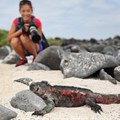Cuddling a lion cub can undermine conservation efforts

Four Paws is one of the largest animal welfare organisations in South Africa fighting for the protection of big cats. However, "not everyone has the best interests of iconic African big cats at heart, and unsuspecting animal lovers could be contributing to the decimation of the lion population, through engaging in animal interactions," says Miles.
These cubs are not orphans
Most of the facilities that offer cub petting activities claim that their cubs were orphaned, abandoned or even rejected by their mother and that the facility has rescued them.
"This is not true: These cubs are bred on demand in captivity to feed these petting establishments with a continuous stream of lion cubs," explains Miles.
There are around 300 farms on which lions are bred and kept for commercial purposes in South Africa. While there are about 3,000 wild lions living in national parks and reserves in South Africa, there are between 8,000 and 10,000 lions living in captivity.
Petting cubs has a negative impact on their health
Big cats sleep many hours a day – especially young cubs. These lion cubs are forced to interact with the paying public for up to 8 to 10 hours a day, resulting in exhaustion.
For these big cats to "safely" interact with people during cub petting and lion walks, they need to be habituated. This involves removing cubs from the care of their mothers within hours to days of birth, to be hand-reared by people.
"This is not only incredibly stressful for the mother and her cubs, but the cubs also don’t receive the goodness of the mother’s milk. As these cubs are not raised by their natural mothers, and often live without adults of their own kind teaching them how to behave, hunt and interact with their peers, they don’t know how to be a big cat," says Miles.
Cub petting feeds the lion trade
Once the lions used in animal interactions, such as cub petting and lion walks, are too big and dangerous to interact "safely" with people, they end up in either the canned hunting industry or killed for their bones to be sold as ingredients of Traditional Chinese Medicine in Southeast Asia
About 600 to 700 captive lions are killed in trophy hunts each year and those that are not killed in canned lion hunts are slaughtered for their bones. This trade stimulates demand for lion bones and incentivises poachers to target lions and sell their bones into these markets. South Africa is the largest legal exporter of lion bones and skeletons for use in Southeast Asia, with an annual export quota of 800 lion skeletons approved in 2018 by the then Department of Environmental Affairs.
Cub petting farms are not sanctuaries
Many petting facilities justify the activity by telling their visitors that the cubs used in these interactions will be reintroduced in the wild and that the interactions are benefitting conservation. Reintroductions of captive-bred and hand-reared lions are virtually impossible to achieve.
Instead of visiting a cub petting farm, rather support a true sanctuary, suggests Miles. Sanctuaries are captive wildlife facilities that don’t breed, trade, or offer interactions and instead provide a forever home to animals that can’t be returned to the wild.
"Alternatively, visit one of South Africa’s beautiful national parks or private game reserves, where you can see these animals in their natural habitat. If we reduce the demand for big cat petting farms, these facilities will eventually cease to exist," stresses Miles.










